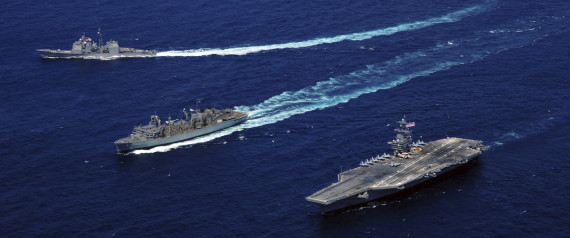 By Ryan Randazzo, The Republic | azcentral.com
By Ryan Randazzo, The Republic | azcentral.com
The U.S. military’s increasing use of alternative fuels and electricity sources is making the nation stronger and helping drive down commercial prices for renewable energy, Navy Secretary Ray Mabus said Thursday in Tempe.
Mabus, who oversees a $170 billion annual budget and about 900,000 people, was speaking to the Arizona State University Global Institute of Sustainability at the Tempe Center for the Arts, and emphasized that renewable energy saves lives in the military.
He used examples ranging from reducing the need to resupply soldiers in combat operations with batteries by providing them with solar power to massive Naval ships running on hybrid electric-fuel systems to remain at sea longer.
In addition to a variety of mandates the Defense Department faces for incorporating renewable energy into its energy portfolio, Mabus set specific goals for the Navy, including getting half its energy needs from non fossil fuel sources by 2020. He said the Navy is on track to meet the goals.
“It will make us better at our jobs, better warfighters, and it will make us, and the world, far more secure,” he said.
Even if the U.S. increases the amount of oil and gas it produces domestically, the military, and consumers, are subject to price spikes triggered by events out of their control, he said.
Every time civil unrest flares up in places such as Libya or Egypt, oil prices rise, which cuts into the Defense Department’s budget. The U.S. military is the single largest user of fossil fuel on the planet, and the largest single energy user in the nation. Each $1 rise in a barrel of oil results in a $30 million increase in annual operating expenses for the Navy and Marines, he said.
He said that other military leaders around the world understand the importance of energy independence. Heads of state understand. People like those in Ukraine who have had energy used against them understand, he said.
“Sustainability for our military forces isn’t just a Unites States concern, our allies are just as interested as we are,” he said. “Sustainability is a global issue.”
Saving fuel allows the military to be more effective. He used the example of the USS Makin Island, a 40,000-ton ship that carries 3,000 personnel, helicopters, landing craft and other equipment.
The ship’s hybrid electric-diesel propulsion system saved $15 million in fuel on one deployment alone, or nearly half the fuel budget for the deployment. That frees up money to be spent elsewhere, he said.
He also cited war zones.
“During the height of operations in Afghanistan, we were losing one Marine, killed or wounded, for every 50 convoys transporting fuel into theater,” Mabus said. “That is far too high a price to pay.”
Marines in Afghanistan began testing solar panels at their forward operating bases to reduce the need for generator fuel, he said. They also used portable solar panels to recharge radios and other equipment, reducing the need for battery resupplies.
“You probably don’t think of Marines as ardent environmentalists, but, as always, Marines are leading the way in providing that renewable energy,” he said. “Alternative energy saves lives.”
The military is using so much alternative energy it is helping drive down costs for consumers, he said. He cited the example of a contract with four companies to provide 160 million gallons of biofuel a year. The average price is less than $3.50 a gallon, “extremely competitive” with traditional fuel, he said. That is down from five years ago when the military was paying several hundred dollars per gallon for experimental fuel from pilot plants.
“As we buy more the cost has been coming down dramatically,” he said. “The Navy is big enough to change a market.”
Similar price drops are being seen in wind, solar and other alternative energy sources the military is using for its bases in the U.S., he said.
Mabus took a question from Andrew Lane, who recieved an Army Graduate Certificate of Sustainability from the school, regarding how the military handles critics who don’t believe in the capabilities of alternative energy or who don’t think climate change is a threat the military should work to mitigate.
“People still want to debate me on climate change,” Lane said.
Mabus responded that the connections between sustainability and defense are clear.
“Sea levels rise, instability follows, and our (military) responsibility increases,” Mabus said. “It is happening whether we want to believe it or not and will have an impact on our military.”
Peter Byck, a documentary film maker and professor of practice at ASU, asked what the Defense Department is doing to spread the word on its efforts.
“The biggest change you have to make is cultural change,” he said. “Change is always hard. I learned it as a governor (of Mississippi). I learned it as an ambassador (to Saudi Arabia). And I’m getting a graduate degree in it here.”